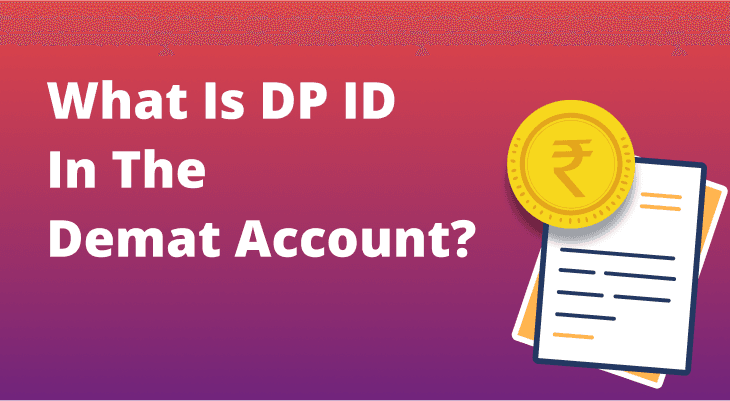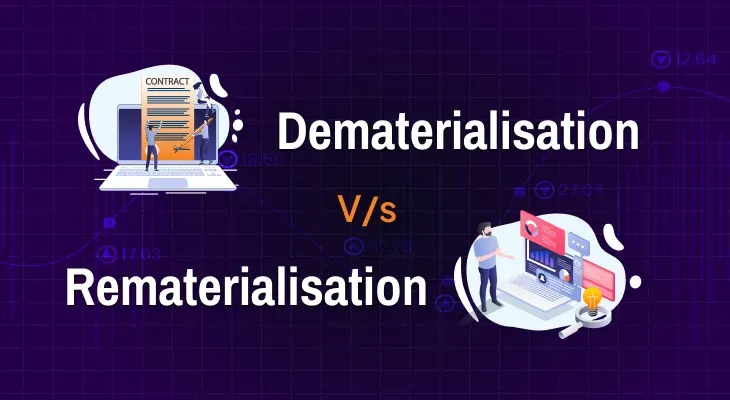
What Is DP ID In The Demat Account?
With a Demat account, you can keep securities and shares digitally, doing away with cumbersome paper certificates. While it is operated by you, it is opened through a Depository Participant (DP). DPs are intermediaries that enable smooth electronic trading of securities, much like banks and brokerage firms. The DP in charge of your account may be identified by the eight-digit DP ID.
Understanding the meaning of DP ID in a Demat account is essential as it ensures the accuracy and security of your transactions. Stock market trading would be far more chaotic and susceptible to errors without it. Let's explore the DP ID's meaning, applications and how it is different from your Demat account number.
What does DP ID Mean?
A central repository assigns each DP a unique eight-digit identifier known as the DP ID or Depository Participant Identification. Central Depository Services Limited (CDSL) and National Securities Depository Limited (NSDL) are the two main depositories in India. These depository institutions oversee the electronic storage of securities and enable smooth trading operations. A Depository Participant serves as an intermediary between the depository and the investor, and examples of these include banks and brokerage firms.
The DP ID is the first part of your 16-digit Demat account number, which is required to execute trades. The next eight digits of this number are the Client ID, which determines individual investors. For example, with a Demat account number like (9876543210123456), the first eight digits (98765432) are the DP ID, while the last half (10123456) is the Client ID.
How DP ID is Used in Demat Accounts?
The DP ID ensures that trading operations are accurate and efficient. Here are some of its key applications:
Accuracy in Trading:
The DP ID ensures that securities transactions are properly routed. This accuracy is critical in preventing mistakes and ensuring that deals are carried out as intended.
Faster Settlement:
The DP ID, included with the Demat account number, allows for faster transaction settlement. Transactions done using a Demat account are handled electronically, resulting in speed and efficiency.
Access to Services:
Your depository offers a variety of services, like e-voting and pledges, that require a DP ID to access. This ensures that only authorised users may use these services.
Tracking Transactions:
The DP ID allows for effortless tracking of transactions within a Demat account. This transparency allows investors to monitor their trades and keep accurate records of their holdings.
Safety and Security:
The depository uses the DP ID to ensure that your transactions are safe and free of unauthorised access or third-party influence.
Example of DP ID in Demat Accounts
Consider the following example to better understand the idea of DP ID:
Suppose you have a Demat account with XYZ Securities Limited. The depository gave XYZ Securities Limited the DP ID 24681012. Therefore, your DP ID with XYZ Securities Limited is 24681012. When you buy shares using this DP, your DP ID is connected to the transaction, ensuring that it is properly completed. Similarly, when you sell shares, the DP ID facilitates the transaction by ensuring that it is directed to the relevant DP for processing.
What is a DP ID in a Demat Account, and Difference Between a DP ID and Demat Number?
The DP ID is a unique eight-digit identification provided to a Depository Participant by a central depository, such as CDSL or NSDL. This code identifies the DP responsible for your account. DPs are financial intermediaries, such as banks or brokerage firms, who manage securities dematerialization. The DP ID guarantees that all transactions in your Demat account are appropriately routed to the correct Depository Participant, resulting in seamless execution and speedier settlements.
Demat account numbers, on the other hand, are 16-digit codes. It has the DP ID as the first eight numbers and the Client ID as the last eight digits. When you create a Demat account, your DP will provide you with this number. The DP ID in a Demat account identifies the Depository Participant, whereas the Client ID identifies you as the individual investor. The Demat account number is used to maintain and track your unique holdings, allowing debits and credits during trading operations.
Differences
Assigning Authority:
The depository (CDSL or NSDL) assigns the DP ID to the Depository Participant, whereas the DP assigns the Demat account number to the investor upon account opening.
Function:
The DP ID ensures that electronic transactions are properly routed between the sending and receiving DPs. In contrast, the Demat account number identifies the individual holdings in the Demat account and allows for the appropriate debits and credits during trading operations.
Differences between a DP ID and a Demat Account Number
Function in Securities Transactions:
DP ID: Enables the accurate routing of securities transactions between DPs in the electronic trading system.
Demat Account Number: Identifies and manages an investor's holdings within the Demat account.
Identification and Tracking:
DP ID: Identifies the DP that facilitates the transaction between the investor and the central depository.
Demat Account Number: Specifically identifies and maintains individual investments stored in the Demat account.
Authority and Regulation:
DP ID: CDSL or NSDL assign DP IDs, which are then regulated by SEBI to ensure compliance and investor safety.
Demat Account Number: Assigned by the DP to represent the investor's specific account data and holdings.
Integration in Trading Platforms:
DP ID: Required for routing transactions to the right DP for processing within the electronic trading system.
Demat Account Number: Required for easy communication with trading platforms, allowing for fast and secure transactions.
Understanding CDSL and NSDL
In India, the Securities and Exchange Board of India (SEBI) oversees two principal depositories: Central Depository Services Limited (CDSL) and National Securities Depository Limited (NSDL). These depositories ensure the secure and efficient processing of securities in electronic format.
CDSL: The Bombay Stock Exchange promotes CDSL, which provides a platform for holding and transferring shares online. Financial organisations such as Bank of India, Bank of Baroda, State Bank of India, and HDFC Bank are among its major contributors.
NSDL: The National Stock Exchange, IDBI, and the Unit Trust of India promote NSDL, which also provides a platform for electronic securities transfer and storage.
When you open a Demat account with either CDSL or NSDL, you will get a welcome letter that includes your 16-digit Demat account number. For CDSL accounts, this number is totally numeric, however for NSDL accounts, it starts with 'IN' and then 14 digits.
Conclusion
Understanding the functions of DP ID and Demat account numbers is critical for handling investments in the stock market. The DP ID implies that transactions between Depository Participants go smoothly, whereas your Demat account number tracks your unique holdings. These identifiers are regulated to safeguard investors and preserve market integrity. Knowing how they function allows you to make informed investment choices. Understanding these fundamentals allows you to use your Demat account properly and get the most out of your investments.
FAQ
How is a Demat account number structured?
The Demat account number is a 16-digit code, with the first eight digits representing the DP ID and the final eight representing the Client ID.
Who assigns the DP ID?
CDSL and NSDL assign the DP ID to Depository Participants.
How vital is it for me to know my DP ID?
Knowing your DP ID is useful since it allows you to identify your Depository Participant. This knowledge is essential for managing your securities transactions and ensuring they are routed to the appropriate intermediary. It also helps to resolve any problems that might arise with your Demat account.
What is the purpose of DP ID in trading?
The DP ID guarantees that securities transactions are accurately routed, allowing for quicker settlements and secure trading.
Can I change my DP ID if I switch Depository Participant?
No, you can't modify your DP ID. The DP ID corresponds to the Depository Participant with whom you created your Demat account. If you switch to a different Depository Participant, you will be assigned a new DP ID.
What is the relevance of CDSL and NSDL?
CDSL and NSDL are India's central depositories, which ensure the safe and efficient processing of electronic securities.
What should I do if I forget my DP ID?
If you've forgotten your DP ID, you may look it up on your Demat account statement or by going into your online trading account. Alternatively, you can contact your Depository Participant's customer service division, who will give you the relevant information.
Is the DP ID the same as the Client ID?
No, the DP ID differs from the Client ID. The DP ID is the first eight digits of your Demat account number, while the Client ID is the last eight.
Can I maintain many Demat accounts with different DPs?
Yes, you can open several Demat accounts with various Depository Participants, each with its own DP ID and Demat account number.
Can I make a trade without knowing my DP ID?
While the DP ID is important for routing transactions, your Demat account number, which contains the DP ID, is required for trading.


